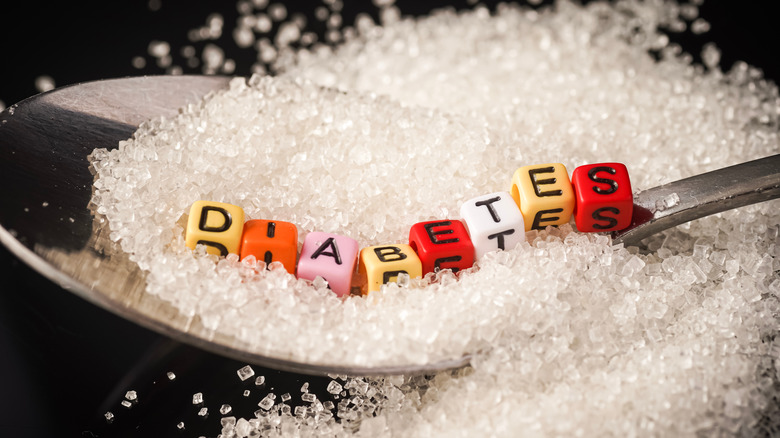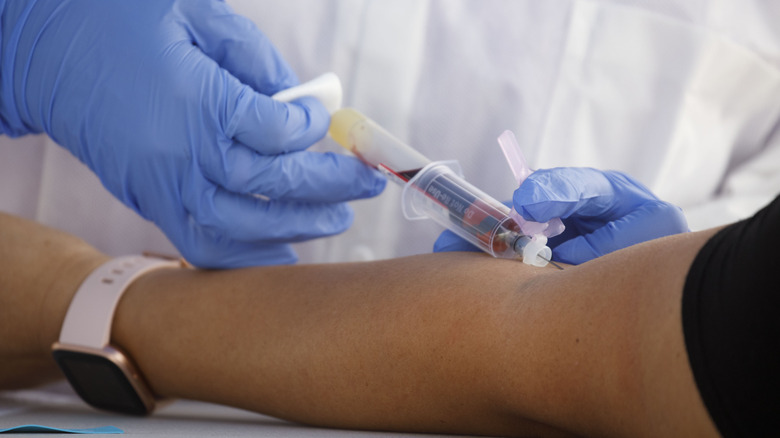What's The Difference Between Being Diabetic And Prediabetic?
According to the Centers for Disease Control and Prevention (CDC), about 88 million American adults have prediabetes — that's one-third of the adult population. But over 84% of them are unaware they have it. Could you be one of them?
You may be confused about what being prediabetic means. But it's important to know the risk factors, signs, and treatments for this health condition that could lead to significant medical problems. While prediabetes may be potentially serious, it's also entirely reversible.
To learn more about prediabetes, which has to do with the level of blood sugar or glucose circulating in the body, it helps to understand a few facts about normal blood sugar levels. In a healthy adult 20 years and older, levels of blood sugar vary depending on how long it's been since the last meal, the person's age, recent physical activity, and a host of other variables, according to The Checkup by Single Care. On a typical day the level may fluctuate from below 100 mg/dL in the morning to about 110 mg/dL two hours after eating. In people with diabetes and prediabetes blood sugar level is higher. For instance, an adult with diabetes may begin the day with a glucose level of less than 100 mg/dL, but it can rise to nearly 180 after eating.
What is diabetes?
There are two types. Type 1 is an autoimmune disease that begins abruptly, usually over several weeks (via Healthline), with severe symptoms, and mostly strikes children and adolescents. In type 1 the pancreas, a pear-shaped gland behind the stomach, becomes incapable of producing insulin or produces very little. Insulin is the hormone essential for ushering sugar (i.e., glucose) into the body's cells where it is used to create energy (according to Endocrine Web).
By far the more common form of diabetes is type 2, affecting up to 95% of those with the disease (per the CDC). Its onset is gradual and it occurs most often in older people, although any age person can develop it. In type 2, the pancreas still produces insulin, but for reasons that aren't clear, the body becomes insulin resistant, which means that the insulin is ineffective in helping glucose enter cells, thereby allowing sugar to build up in the blood.
A major difference between the two variants is that while type 1 cannot be prevented, type 2 almost always evolves from prediabetes, giving the patient time — generally years — to reverse the condition and prevent full-blown diabetes. However, prediabetes may not show any symptoms. So how does a person know they have it and are vulnerable to developing diabetes?
Diagnosing prediabetes
Because prediabetes may lurk invisibly in the body for years, it's important to get blood glucose levels tested if you have any of these risk factors: excess weight (particularly in the abdomen), smoking, a diet high in sugar and processed foods, being sedentary, a close family member with type 2 diabetes, age 45 or older, a history of gestational diabetes, or being African American or a member of certain other races, according to Endocrine Web.
Your doctor will likely order a blood glucose test to measure the amount of sugar circulating in your bloodstream. To get precise results, you'll need to fast for eight hours beforehand. In a normal adult, fasting glucose levels are 99 mg/dL or lower. Results that fall between 100 and 125 mg/dL indicate prediabetes, Martha McKittrick, R.D., tells Endocrine Web. Anything higher than 126 mg/dL represents diabetes.
Prediabetes is basically when blood sugar levels are higher than normal, but not high enough to be considered diabetes. It's a clear warning bell to alert you to the possibility that you'll develop diabetes sometime in the future, unless you take immediate steps.
Reversing prediabetes
How long it takes to progress from prediabetes to diabetes depends on a variety of factors, such as how active you are and how severe your prediabetes is (per GoodRx). It's best to begin right away with the following lifestyle changes for lowering blood glucose levels.
Improve your diet. Opt for whole grains rather than processed carbs, water instead of sugary drinks, poultry and fish in place of red meat, and good fats in nuts and vegetable oil rather than the unhealthy fats in fried and baked goods, suggests WebMD.
Start exercising. Aim for a half hour a day, five days a week. The combination of a healthier diet and physical activity will help you lose weight. Even a loss of just 5% to 7% of your body weight (10 to 14 pounds for someone who's at 200) will lower blood sugar levels, as well as your chances of developing diabetes (per the CDC).
In certain cases, a medication called metformin may be needed. It will help the liver produce less glucose and prevent sugar in the foods you eat from being absorbed into the bloodstream.




